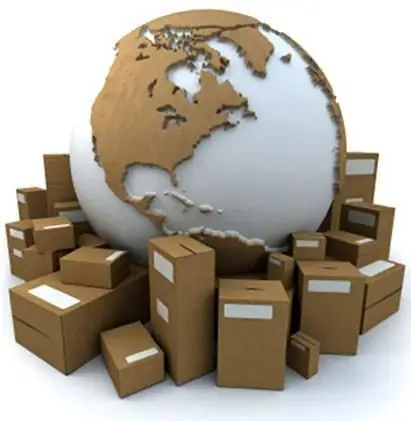2025 Author: Howard Calhoun | [email protected]. Last modified: 2025-01-24 13:10:37
To simplify the procedure for moving products across the border, the Customs Union (CU) has developed a whole system of classification of goods. This system was called TN VDE TS.

HS codes - what is it?
The system, or, as it is also called, the classifier of goods, is successfully used by the bodies of the Customs Union. The system itself, in turn, is constantly being refined and supplemented by each of the countries participating in the CU. In the Russian Federation, the bodies of the Federal Customs Service develop and supplement the discussed classifier. Today you will learn how to decipher TN VED codes,and also get comprehensive information on the issue under discussion.
About classifier
Each product, according to the Commodity Nomenclature of Foreign Economic Activity of the Customs Union, was assigned codes. They consist of the same numbers and, knowing how to read them, it is possible, only based on one code, to characterize the product. The correctness of the compilation of codes is monitored by authorized representatives of the Customs Union. The most common are ten-digit codes, but some types of goods are assigned 13-digit codes. They are indicated by the declarants during the implementationcertain stages of customs procedures. Customs codes of the TN VED greatly facilitate the passage of customs clearance, while facilitating the procedure for calculating the duty for export (import) of goods.
The classifier itself has 21 sections, which are divided into 99 groups. There are three groups of goods that are not currently used. These include goods of groups 77, 98 and 99.
What is the classification based on?
When creating TN VED codes, a number of criteria are used. The main ones are:
1. The material that served as the raw material for the manufacture of goods.
2. The functions that the exported (imported) product performs.
3. The degree of processing of the goods. In other words, how the product is made.
4. Mass in kilograms, which is the main unit used to measure goods, according to the classification discussed in the article.
What is the TN VED code of the Customs Union?

So that you never again have questions about the meanings of the numbers of the customs classifier, the following are illustrative examples that will allow you to understand this issue.
Let's analyze the TN VED CU code using beet sugar as an example. As noted above, the product code, as a rule, consists of ten digits. The code is read from left to right and is divided into four main groups.
- Let's say the first two digits are 17. They indicate that the imported goods are goods that contain sugar in their composition, or thatthe imported commodity is sugar. The first two digits are called the general commodity group. If the group number is below 10, then it is written with a zero (for example - 07).
- If we consider the first four numbers (for example, 1701), then we can determine that we have sugar in front of us, but what composition it is from, it will be impossible to understand without subsequent numbers. The first four digits are the name of the heading.
- The first six digits, in turn, indicate the commodity subheading. For example, the code value 170112 can be interpreted as beet sugar.
- The last four digits contain clarifying points about the imported goods. The full product code has the name of a sub-subitem. It contains moments that clarify the smallest details that relate to the product. For example, data about changes, customs duties and other information.

Summing up this block of the article, it can be noted that the TN VED CU code consists of four parts:
1) The first two digits are referred to as the commodity group.
2) The first four digits are referred to as the heading.
3) Commodity subitem - first six digits.
4) Commodity sub-subheading - the entire product code.

Preimage of classifier
The code of goods according to the TN VED was not always in use with the Customs Union. Once its function was performed by the Harmonized System, which was successfully used in customs procedures between the members of the European Union. She served as a prototype of the TN VED CU. But in the courseThe classification system discussed in the article has received a number of changes and now it differs significantly from the Harmonized System.
It is also worth noting that, according to the new regulations, products that are classified according to HS standards may not be allowed to be imported through the territory of the Russian Federation and other countries participating in the Customs Union. According to the law, the authorized customs authority may not take into account the code of the goods, which was assigned by the manufacturer or supplier himself. In other words, TN VED codes are mandatory when it comes to importing goods across the border of the Customs Union countries.
Who is responsible for product classification?

The declarant is the main authorized person who deals with the classification of products. In some cases, the representative of the declarant classifies products according to the FEACN. In this case, it is mandatory to control the correctness of the classification from the authorized customs authority. When checking the correctness of the code, the customs authority has the right:
1) confirm that the code is correct and pass the goods to other customs procedures;
2) reassign customs code;
3) oblige the declarant to reassign the code, which is extremely rare.
If the authorized customs control authorities have no doubts that the TN VED codes are correct, this code will be used to determine the amount of customs duty.
Recommended:
Plan of financial and economic activities of a budgetary institution: an example of compilation, items of expenditure and income

In accordance with the legislation of the Russian Federation, budgetary institutions must draw up plans for financial and economic activities. What are the features of solving this problem?
Customs fees and customs duties: types, description, calculation and accounting procedure

What is this? Import and export groups. Classification by purpose of collection, objects of taxation, method of calculation, nature and state of origin. What is special duty? How are these payments calculated?
Customs services are The system, management and types of customs services

Services related to foreign economic activity are divided into two types: public and private. Public services are the prerogative of the Federal Customs Service. Private companies turn out to be different companies depending on the profile
Classes of the Nice Classification: codes, list and classifier. What is the International Classification of Goods and Services?

For the registration of each mark of new products in business, the International Classification of Goods and Services is used. At the initial stage, the applicant determines under which category his activity falls. In the future, this will be the basis for the implementation of registration procedures and determining the amount of the fee paid by the entrepreneur
How to find out the budget classification code? Budget classification codes for taxes

The problem of how to find out the budget classification code arises in front of almost every taxpayer when the deadline for paying taxes comes. No one can avoid it: neither the accountant of the organization responsible for the relevant transfers to the tax office, nor ordinary citizens who own housing, land, a car or a simple outboard motor

